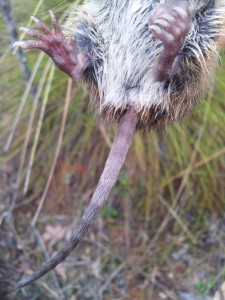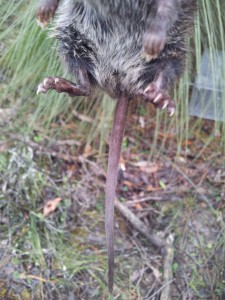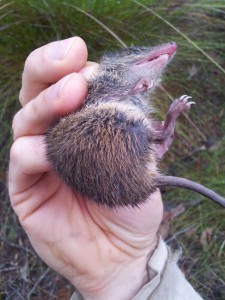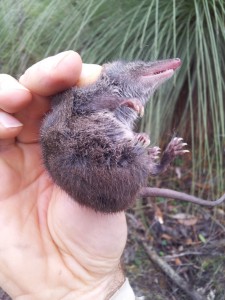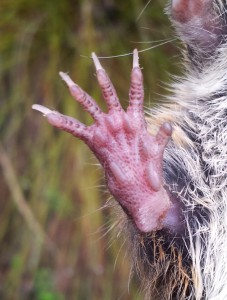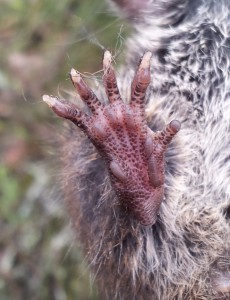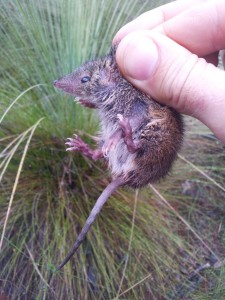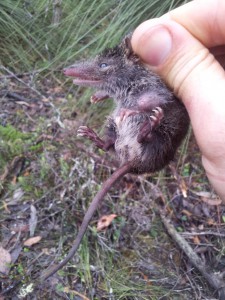The secrets of Lower Glenelg River Conservation Park revealed – a new species for South Australia!
Well, after another busy week of small mammal survey work down in Lower Glenelg River Conservation Park, unfortunately our target species – the Heath Mouse – was not found. Looking back over my old records, it turns out that I haven’t captured them in this reserve since 2004, even though I continued annual surveys down there until 2007. It also didn’t help that we had a rampant crew of Brushtail Possums setting off and turning over traps – and occasionally being cage trapped as well – leading to 8 being caught on the last day of the survey. This is the most Brushtail Possums I’ve ever encountered in a day before!
Thankfully there were a couple of days when some antechinus were also caught, with the first of these causing me to scratch my head. As first glance it looked a lot like a swamp antechinus, but it was too big and heavy for this time of year. As I started looking over the key diagnostics, I started to wonder – could this be a Dusky Antechinus? The Dusky Antechinus (Antechinus swainsonii) is the largest species of antechinus, and becomes common as you head east through the coolest parts of southern and mountainous Victoria. The nearest previous record to the survey location was about 40 km to the east near Drik Drik.
Then, in a stroke of luck, the following day I had sequential captures (a few minutes apart) of a juvenile male Swamp Antechinus (29 grams) followed by a juvenile female Dusky Antechinus (39 grams) – which gave me the fresh opportunity to check the key diagnostics I have worked on for telling the species apart, and that I then also photographed (see below). So I’m now 100% certain that we have a new species for South Australia – but obviously given the location (opposite the River at Donovans) only just!
The photos below (click to enlarge) show a few of the key diagnostics:
1 – The tail in the Swamp Antechinus is proportionally shorter than the Dusky, and has a different appearance in terms of general colour and hairiness. You can also see the difference in belly fur colour in these images.
2 – The rump/back fur of both species is darker than underbelly fur and somewhat grizzled, but the swamp antechinus has a much stronger auburn tinge.
3 – The hind foot images show the general darker pigmentation of the Dusky (also visible on the skin of the tail and ears) and while both species have “granules” on the skin of the feet, these are much darker in the Dusky.
4 – The general appearance of the Dusky when you see them as I did – almost side-by-side – is actually more different than I realised. Having looked back over a few images I’ve now taken, the head shape is a bit different (flatter and pointier in side-profile in the Dusky) and the proportional size of the tail (relative to the body) is really apparent when looking at the whole animal. The Dusky here is also 25% heavier/larger than the Swamp Antechinus, even though they were born in the same season.
Then, in an interesting (and tad embarrassing) footnote to this exciting tale, it turns out – after doing a bit of digging through my old data – that I may have missed a Dusky Antechinus in my survey at the same site, back in 2006!
I crossed checked all the weight/date data for swamp antechinus captures in Lower Glenelg, and found an outlier. A male captured on the 29th of March 2006, that weighed 92 grams. While I have caught some big swamp antechinus males in productive coastal tea-tree swamps by that time of year, I’ve never had any males anything near this size in the less productive heathy woodland habitat of Lower Glenelg – not even by peak breeding time in June (maximum male weight I’ve encountered 70g).
Thankfully, it also just so happens that I have a photograph of this animal – see below – and for me confirms that this is indeed a Dusky. It seems clearer now than it must have on the day – but looking over the records, I hadn’t captured and handled a swamp antechinus for over a year at that date – so I mustn’t have been tuned in as well as I should have been… So it turns out that this species was actually first discovered in South Australia 7 years ago – I just didn’t realise it until now – what an interesting week!
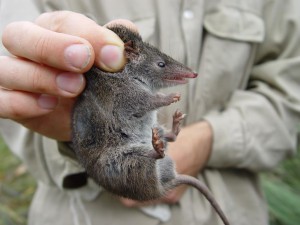
Better to work it out seven years later than never! What is probably the “real” first record of a Dusky Antechinus in SA – this male captured in March 2006.
PS – The observations I have shared here will be put to the test, with the SA Museum planning to undertake some genetic analysis of small ear tissue samples I have collected from the animals referred to above, to confirm the species identification. I’ll let you know the outcome – here’s hoping that I haven’t got ahead of myself!


